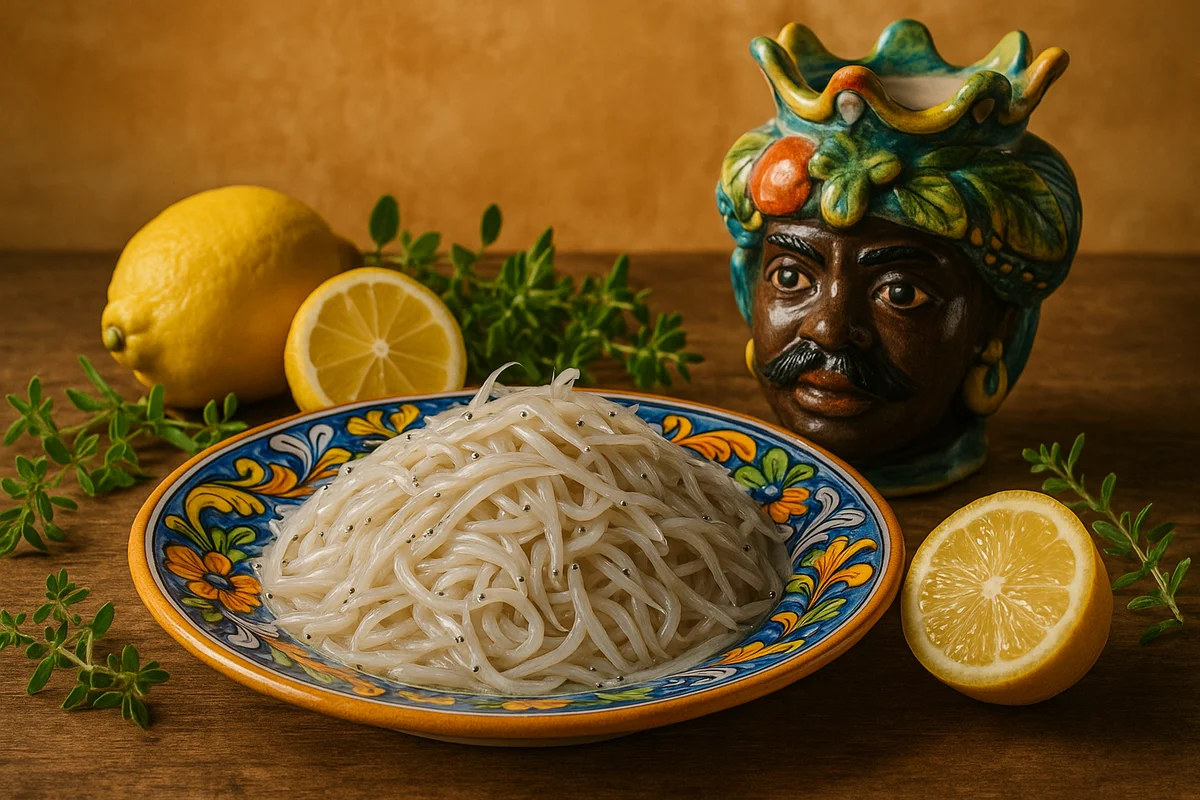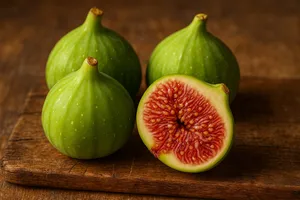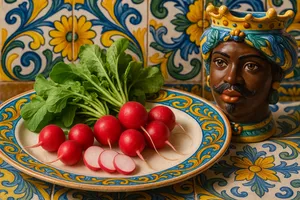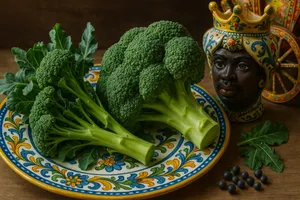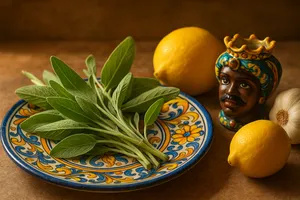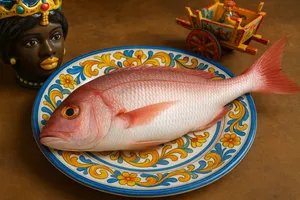Overview
Juvenile blue fish, known in Sicilian as "nunnata", "masculina" or "cicirelli", refers to very young anchovies (Engraulis encrasicolus) and sardines (Sardina pilchardus) caught when only a few centimetres long—generally between 2 and 5 cm. These tiny transparent or silvery fish, with their extremely delicate flavour, were for centuries an important seasonal resource for Sicilian coastal communities, consumed fresh in simple preparations that highlighted their tenderness and freshness.
In Sicilian tradition, juvenile blue fish was considered a seasonal delicacy, especially abundant in spring. It was caught at night with ultra-fine nets, when the young fish rise toward the surface attracted by light. Traditional preparations were simple—fried, in frittata, briefly boiled and dressed with lemon and oil, or formed into meatballs. Today, however, it is essential to note that the fishing of juvenile blue fish is heavily regulated and restricted in Italy and the EU for sustainability reasons, as it is considered harmful to fish populations. Catching fish before they have had a chance to reproduce contributes to the depletion of stocks. For this reason, the consumption of juvenile blue fish is now controversial and often illegal, with penalties for those who fish or sell it unlawfully.
Characteristics
Juvenile blue fish appears as very small fish, generally 2–5 cm long, elongated and slender. Their bodies are transparent or silvery, with the bluish reflections typical of blue fish. They are extremely fragile and spoil quickly.
The flavour is very delicate—marine, slightly sweet. The texture is extremely tender, almost melting in the mouth. The scent is clean and fresh; any strong or unpleasant odour indicates deterioration.
Fresh juvenile blue fish has bright eyes, a glossy body and a delicate marine aroma. It deteriorates within hours of being caught, making absolute freshness essential. Any dull appearance or strong smell means it should not be consumed.
Types
Nunnata (gianchetti)
Tiny anchovies, transparent or whitish, 2–3 cm long. The smallest and most delicate. Called “gianchetti” in Liguria and “nunnata” or “masculina” in Sicily.
Cicirelli
Slightly larger young sardines, 3–5 cm long, already with more noticeable silver colouring. They have a slightly firmer texture than nunnata.
Bianchetti
A general term used in various Italian regions for juvenile blue fish.
Sustainability issues
The fishing of juvenile blue fish raises serious sustainability concerns. Catching fish before they reach reproductive maturity prevents the renewal of fish stocks. Each kilogram of juvenile fish represents thousands of individuals that will never reach adulthood.
For these reasons, the European Union and Italy have strict regulations:
- Fishing juvenile blue fish is banned or heavily restricted for most of the year
- Legal minimum sizes for anchovies and sardines are set (9–11 cm depending on area)
- Selling juvenile fish below legal size is illegal
- Heavy fines apply to those who fish, sell or purchase illegal juvenile fish
Some periods and zones have limited exemptions for small-scale traditional fishing, but regulations are strict. Marine scientists and fisheries-management organisations strongly advise avoiding consumption so that depleted Mediterranean stocks can recover.
Traditional culinary uses
Historically, when fishing was permitted, juvenile blue fish was used in various Sicilian dishes.
Fried juvenile fish
The most classic preparation: lightly floured and fried quickly in hot oil, producing a delicate and crispy result. They were eaten whole due to their tiny size.
Frittata
Mixed with beaten eggs and cooked as an omelette—an economical way to feed a family.
Boiled and dressed
Briefly boiled in salted water (or seawater), then dressed with extra virgin olive oil, lemon and parsley.
Meatballs
Mixed with soaked bread, eggs, cheese and parsley to form small fried meatballs—useful for stretching less-fresh fish.
Pasta with juvenile blue fish
A quick preparation with garlic, oil, chilli and toasted breadcrumbs.
Traditional preparation
Juvenile blue fish requires no cleaning due to its tiny size. It is simply rinsed gently in cold water to remove impurities.
For frying, it is lightly floured (or not at all) and dipped into very hot oil for just a few seconds. Overcooking ruins its delicate texture.
Sustainable alternatives
Given the environmental concerns, sustainable alternatives should be preferred:
Adult anchovies and sardines: Fish that have reached legal size and reproduced. Their flavour is stronger but they are abundant and sustainable when caught with selective methods.
Small legal-sized blue fish: Anchovies, sardines and mackerel offer similar nutritional benefits and can be used in similar preparations.
Zerri and legally sized cicireddi: Some small species naturally reach adulthood at small sizes and can be consumed sustainably.
Nutritional properties
Being juvenile blue fish, they share excellent nutritional qualities with adult anchovies and sardines: high-quality protein, essential omega-3 fats, calcium (since they are eaten whole), B vitamins, vitamin D and selenium.
They are highly nutritious, low in calories and low in saturated fats. However, sustainability concerns outweigh nutritional benefits, which can be obtained from adult blue fish instead.
The legal framework
In most areas and times of the year, fishing, selling and consuming juvenile blue fish below legal minimum size is prohibited. Penalties include large fines and product seizure. Restaurants serving illegal juvenile fish risk closure and serious sanctions.
Consumers contribute to illegal fishing if they purchase such products. Responsibility is shared: choosing not to consume juvenile fish helps protect Mediterranean stocks.
Cultural change
In traditional Sicily, juvenile blue fish was cherished, and its fishing was a centuries-old practice. Changing habits takes time; some fishermen and consumers view restrictions as an intrusion on heritage.
However, fisheries science clearly shows that juvenile fishing is unsustainable. Populations of anchovies and sardines in the Mediterranean are declining, and juvenile fishing is one of the contributing factors.
Fisher organisations, NGOs and institutions are working to raise awareness about protecting blue fish, a precious Mediterranean resource. The message is clear: giving up juvenile fish today means ensuring abundant anchovies and sardines tomorrow.
Curiosities
Juvenile fish were traditionally caught at night using bright lamps (lampare) to attract them toward the surface—an impressive sight on the dark sea.
Some Sicilian families once guarded secret recipes for preparing juvenile fish. As legal fishing declines, many of these recipes are fading, though this may ultimately benefit sustainability.
In times of past abundance, juvenile fish was sometimes even used as animal feed or fertiliser—an indication of once-vast quantities. Today, such abundance is only a memory.
Elderly fishermen recall spring seasons when nets overflowed with juvenile fish. Now, even where permitted under exemption, catches are a fraction of what they once were—a clear warning sign from nature.
Debates over juvenile fish have pitted tradition against conservation. Fishermen protest restrictions, while environmentalists highlight the urgency of protecting marine resources. Limited exemptions attempt to strike a balance, but the trend is toward tighter rules.
Some environmentally conscious Sicilian chefs have voluntarily removed juvenile fish from their menus, even when legally available, choosing instead to reinterpret traditional dishes using adult blue fish to preserve both heritage and sustainability.

